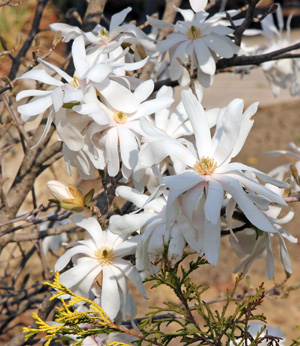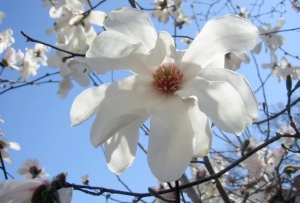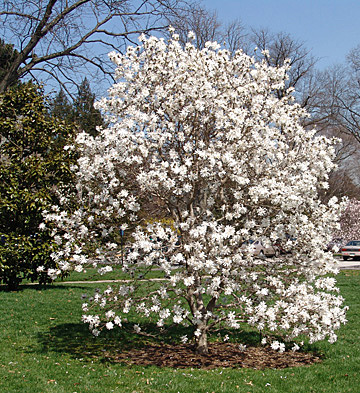Magnolia Stellata: Star of the Spring Garden
By Pat Dickey, Fairfax Master Gardener
 One of the best indicators that spring is just around the corner is the appearance of the showy white flowers of the star magnolia (Magnolia stellata). In a foundation grouping at the entrance to my condominium, they stand like a choir in formation, welcoming the first days of warmer weather.
One of the best indicators that spring is just around the corner is the appearance of the showy white flowers of the star magnolia (Magnolia stellata). In a foundation grouping at the entrance to my condominium, they stand like a choir in formation, welcoming the first days of warmer weather.
The star magnolia is originally from the Japanese island of Honshu and was introduced to the United States in the 1860s. It works well as part of a foundation planting or as a single specimen. Even before it blooms, the star magnolia has a heavily branched, twiggy structure that offers visual winter interest. It has striking, gray bark on the trunk and chestnut brown bark on its young twigs. Pussy willow-like casings cover the buds on the twigs during the winter, and the buds swell to release the flowers in early spring. The star magnolia can be trained to grow as either a large shrub or, by removing the lower basal branches to expose the smooth mottled bark, as a multi-stemmed small tree.
The star magnolia grows to a height of 15 to 25 feet with a spread of 10 to 15 feet at maturity. It also adapts to a variety of soil types including acidic, loamy, moist, sandy, well-drained, and clay. It can tolerate the extremes of some flooding and moderate drought. This magnolia is best planted in full sun to partial shade, with a minimum of 4 hours of unfiltered sunlight each day. It is considered the hardiest of all the magnolias and requires less maintenance and fewer resources than comparable plants. There are few insect problems and diseases, and once established, it needs little supplemental water and fertilizer.

Magnolia stellata ‘Dr. Merrill’
In late February to April, depending on the location, white or light pink flowers bloom. They are 3 to 4 inches across and have 12 to 20 petals radiating from the center. The star-like flowers are even more noticeable because they appear before the leaves emerge. The flowers may last from 10 to 20 days because not all of them open at the same time. The plant becomes covered in these fragrant blossoms from the top of the tree to the lowest branches. These flowers are most striking when the star magnolia is planted near a contrasting brick wall or an evergreen hedge.
When the dark green leaves of the star magnolia finally emerge, they are 3 ½ to 4 inches long and are obovate, oval with a narrower end at the base, and they alternate on the stem. The leaves are much smaller and denser than those of other magnolias. The star magnolia also bears many cone-like and twisted knobby fruit clusters. They are 2 inches long and often drop before fully developed in late summer. If they mature, the fruit reveals reddish-orange seeds. The star magnolia can be propagated from seed or by taking cuttings in early to mid summer.

Magnolia stellata ‘Centennial’
Several varieties of star magnolia are available. ‘Centennial‘ was first released by Harvard’s Arnold Arboretum to commemorate the institution’s 100th anniversary in 1972. The flowers are white with a hint of pink, and the more upright shrub or tree reaches 25 feet tall. ‘Jane Platt’ has pink flowers and has 20 to 30 petals. ‘Rosea’ is a name that covers several light-pink-flowered clones and grows to 15 feet tall. ‘Royal Star,’ the most common in the nursery trade, opens white flowers from pink buds slightly later than other selections. It becomes a densely branched shrub and grows to 10 feet tall. ‘Waterlily’ has pink buds that open to light-colored fragrant flowers with many petals. It forms an upright large shrub or small tree and grows to 15 feet tall.
This is a great flowering tree for a small yard, since it keeps its short and compact appearance. You can enjoy the light fragrance of the flowers by planting it near a patio. The star magnolia is also a great addition for the edge of a woodland garden. Consider it when making your next tree selection.
References
(V Tree) Magnolia stellata, Virginia Tech dendrology
Star Magnolia, The Morton Arboretum, Lisle, IL
Star magnolia: Magnolia stellata, University of Wisconsin Master Gardener program
Magnolia stellata, Arbor Day Foundation
Dirr’s Hardy Trees and Shrubs: An Illustrated Encyclopedia, Michael A. Dirr, 1997
… updated 2021